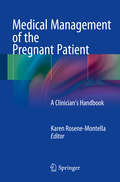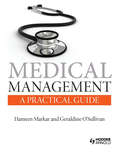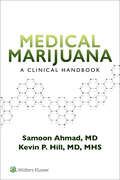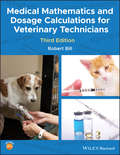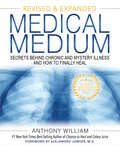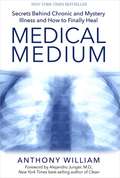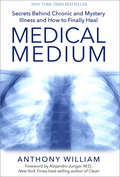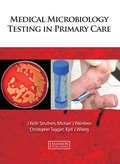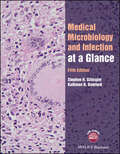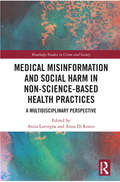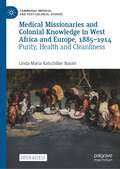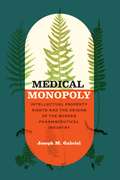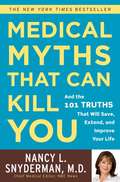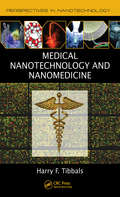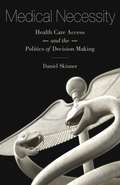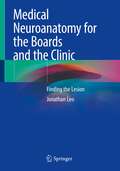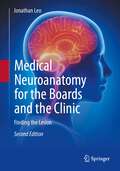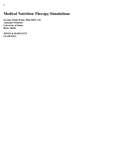- Table View
- List View
Medical Management of Wildlife Species: A Guide for Veterinary Practitioners
by Sonia M. Hernandez Heather W. Barron Erica A. Miller Roberto F. Aguilar Michael J. YabsleyThis book offers an all-encompassing resource for reliable information on the medical management of wild birds, mammals, amphibians, and turtles. Focusing on the medical information relevant to the wildlife setting, it covers triage, emergency care, and other key considerations in handling, diagnosing, and treating wild animals. The book's population-based approach encourages practitioners to understand individual animal care within the broader context. Medical Management of Wildlife Species: A Guide for Practitioners begins with a brief summary of natural history, and introductory chapters address general topics such as pre-release conditioning, post-release monitoring, and legal issues associated with handling wildlife species. Species-specific chapters provide practical information on medical management, including the most prevalent concerns for each species and the epidemiology of infectious diseases. Provides a complete reference to handling, diagnosing, and treating wild species Covers the full range of North American wildlife Includes concepts that can be applied to species globally Emphasizes information relevant to the wildlife setting Focuses on individual medicine, firmly grounded within population medicine for a broader approach Targeted at wildlife veterinarians, veterinary clinicians that will be presented with wildlife, veterinary technicians, and wildlife rehabilitators Medical Management of Wildlife Species is a must-have addition to the bookshelf of wildlife veterinarians and any veterinarian seeing occasional wild animals, as well as wildlife biologists and researchers.
Medical Management of the Pregnant Patient
by Karen Rosene-MontellaThis protocol-based book uses algorithms to discuss preconception care, care during pregnancy, labor and delivery, and the link between postpartum and ongoing primary care. The need for an educated provider community to care for pregnant patients is enormous, and Medical Management of the Pregnant Patient provides a practical handbook that addresses all aspects of this topic. A brief overview of physiology, its impact on pregnancy and diagnostics, and treatment recommendations are included. Each section covers both diseases that may exist independent of pregnancy and diseases unique to pregnancy. Additionally, symptom-based complaints are incorporated into each section and cross-referenced appropriately. Internal medicine physicians, obstetricians, family practitioners and gynecologists alike will benefit from the practical clinical guidelines presented in this book.
Medical Management of the Surgical Patient
by Michael F. Lubin Md Thomas F. Dodson Neil H. Winawer Michael F. Lubin Thomas F. DodsonThis comprehensive textbook, now fully revised, rewritten and up-dated in its fourth edition, provides an authoritative account of all aspects of perioperative care for surgical patients. All areas of medical disease are discussed with clear recommendations for work up and management in the perioperative period. Basic discussions of surgical procedures are included to help non-surgeons understand the procedures and their implications for patient care. This definitive account includes numerous contributions from leading experts at national centers of medical excellence.
Medical Management: A Practical Guide
by Hameen Markar Geraldine O'SullivanThis essential guide provides a lifeline to authoritative, reliable information on medical management, giving you all the skills you need whether managing a junior colleague as a lead doctor, or running multidisciplinary consortia in the NHS or private sectors.Learn key skills from leadership, managing change, quality control, and project managemen
Medical Marijuana: A Clinical Handbook
by Samoon Ahmad Kevin HillWritten by experienced clinicians for practicing physicians and other health care providers, this timely handbook presents today’s available information on cannabis and its uses in all areas of patient care. Medical Marijuana: A Clinical Handbook summarizes what is currently known about the positive and negative health impacts of cannabis, detailed pharmacological profiles of both THC and CBD, considerations for each medical specialty, treatment approaches used by practicing clinicians, and insights into the history of cannabis and the current regulatory environment in the United States. This concise, easy-to-navigate guide is an invaluable resource for physicians and residents, nurse practitioners, pharmacists, and other clinicians who seek reliable clinical guidelines in this growing area of health care.
Medical Marijuana: Dr. Kogan's Evidence-Based Guide to the Health Benefits of Cannabis and CBD
by Joan Liebmann-Smith Mikhail KoganAn essential guide to understanding the health benefits of marijuana and CBDMarijuana has been used for thousands of years as a medicine, but pot has been illegal in the United States for most of our lives. Almost all states have now legalized its medical use, and many consumers and physicians are exploring it as an alternative to conventional treatments. There&’s substantial evidence that marijuana (cannabis) is a safe and effective treatment for chronic pain, chemo side effects, sleep and mood disorders, MS, and Parkinson&’s disease, among others. But there&’s also misinformation about marijuana on social media. And most physicians have limited knowledge on the subject, while dispensary staff (aka &“budtenders&”) lack medical training. Mikhail Kogan, MD, a renowned expert on medical marijuana, has found that cannabinoids (THC, CBD, hemp, and other cannabis products) can often be more beneficial, have fewer side effects, and be safer than many conventional medications, including opioids and other painkillers. But different ailments require different strains, doses, and routes of delivery. Medical Marijuana demystifies marijuana and other forms of cannabis in a user-friendly guide that will help readers: • Understand how marijuana morphed from the days of &“Reefer Madness&” to being hailed as a wonder weed • Navigate the complex medical and legal world of marijuana • Understand the risks and benefits of THC, CBD, and other cannabis products • Evaluate the pros and cons of inhaled and other routes of delivery: edibles, topicals, and even suppositories • Find a doctor who can recommend medical cannabis • Choose a reliable dispensary • Learn how to evaluate labels on cannabis products • Discover cost-saving strategies since medical marijuana isn&’t covered by health insurance With real-life patients&’ stories woven throughout the book, simple explanatory graphics, and the most up-to-date information, this is the definitive guide to the wide-ranging benefits of medical marijuana and other forms of cannabis.
Medical Mathematics and Dosage Calculations for Veterinary Technicians
by Robert BillThis user-friendly guide to medical mathematics helps veterinary technician students develop the math skills required before going into the practice setting. New workbook format allows readers to practice problems right inside the book Covers math fundamentals, metric and non-metric conversions, dosing and concentration, IV drug infusion, prescriptions, and doctors' orders Offers step-by-step instructions for performing calculations Newly expanded to include calculation of constant rate infusions, dilutions, compounding, and anesthesia applications Features a full answer key and images from the book in PowerPoint for instructors on a companion website
Medical Medium Revised and Expanded Edition: Secrets Behind Chronic and Mystery Illness and How to Finally Heal
by Anthony WilliamFrom the #1 New York Times best-selling author of the Medical Medium series, a revised and expanded edition of the book that started a health revolution..Anthony William, the Medical Medium, has helped millions of people heal from ailments that have been misdiagnosed or ineffectively treated or that doctors can't resolve on their own. Now he returns with an elevated and expanded edition of the book where he first opened the door to healing knowledge from over 30 years of bringing people's lives back. With a massive amount of healing information that science won't discover for decades, Anthony gets to the root of people's pain or illness and what they need to do to restore their health now--which has never been more important. His tools and protocols achieve spectacular results, even for those who have spent years and many thousands of dollars on all forms of medicine before turning to him. They are the answers to rising from the ashes.Medical Medium reveals the true causes of chronic symptoms, conditions, and diseases that medical communities continue to misunderstand or struggle to understand at all. It explores the solutions for dozens of the illnesses that plague us, including Lyme disease, fibromyalgia, adrenal fatigue, ME/CFS, hormonal imbalances, Hashimoto's disease, MS, RA, depression, neurological conditions, chronic inflammation, autoimmune disease, blood sugar imbalances, colitis and other digestive disorders, and more. This elevated and expanded edition also offers further immune support, brand-new recipes, and even more solutions for restoring the soul and spirit after illness or life events have torn at our emotional fabric. Whether you've been given a diagnosis you don't understand, or you have symptoms you don't know how to heal, or someone you love is sick, or you're a doctor who wants to care for your own patients better, Medical Medium offers the answers you need. It's also a guidebook for everyone seeking the secrets to living longer, healthier lives. "The truth about the world, ourselves, life, purpose--it all comes down to healing," Anthony William writes. "And the truth about healing is now in your hands."
Medical Medium: Secrets Behind Chronic And Mystery Illness And How To Finally Heal
by Anthony WilliamAnthony William, the one and only Medical Medium, has helped tens of thousands of people heal from ailments that have been misdiagnosed or ineffectively treated or that doctors can't resolve. He's done this by listening to a divine voice that literally speaks into his ear, telling him what lies at the root of people's pain or illness and what they need to do to restore their health. His methods achieve spectacular results, even for those who have spent years and many thousands of dollars on all forms of medicine before turning to him. Now, in this revolutionary book, he opens the door to all he has learned in over 25 years of bringing people's lives back: a massive amount of healing information, much of which science won't discover for decades, and most of which has never appeared anywhere before. In his New York Times best-selling book, Medical Medium, he reveals the root causes of diseases and conditions that medical communities either misunderstand or struggle to understand at all. It explores all-natural solutions for dozens of the illnesses that plague us, including Lyme disease, fibromyalgia, adrenal fatigue, chronic fatigue syndrome, hormonal imbalances, Hashimoto's disease, multiple sclerosis, depression, neurological conditions, chronic inflammation, autoimmune disease, blood sugar imbalances, colitis and other digestive disorders, and more. It also offers solutions for restoring the soul and spirit after illness has torn at our emotional fabric. Whether you've been given a diagnosis you don't understand, or you have symptoms you don't know how to name, or someone you love is sick, or you want to care for your own patients better,Medical Medium offers the answers you need. It's also a guidebook for everyone seeking the secrets to living longer, healthier lives. "The truth about the world, ourselves, life, purpose--it all comes down to healing," Anthony William writes. "And the truth about healing is now in your hands. "
Medical Medium: Secrets Behind Chronic And Mystery Illness And How To Finally Heal
by Anthony WilliamAnthony William, the one and only Medical Medium, has helped tens of thousands of people heal from ailments that have been misdiagnosed or ineffectively treated or that doctors can’t resolve. He’s done this by listening to a divine voice that literally speaks into his ear, telling him what lies at the root of people’s pain or illness and what they need to do to restore their health. His methods achieve spectacular results, even for those who have spent years and many thousands of dollars on all forms of medicine before turning to him. Now, in this revolutionary book, he opens the door to all he has learned in over 25 years of bringing people’s lives back: a massive amount of healing information, much of which science won’t discover for decades, and most of which has never appeared anywhere before. Medical Medium reveals the root causes of diseases and conditions that medical communities either misunderstand or struggle to understand at all. It explores all-natural solutions for dozens of the illnesses that plague us, including Lyme disease, fibromyalgia, adrenal fatigue, chronic fatigue syndrome, hormonal imbalances, Hashimoto’s disease, multiple sclerosis, depression, neurological conditions, chronic inflammation, autoimmune disease, blood sugar imbalances, colitis and other digestive disorders, and more. It also offers solutions for restoring the soul and spirit after illness has torn at our emotional fabric. Whether you’ve been given a diagnosis you don’t understand, or you have symptoms you don’t know how to name, or someone you love is sick, or you want to care for your own patients better, Medical Medium offers the answers you need. It’s also a guidebook for everyone seeking the secrets to living longer, healthier lives. "The truth about the world, ourselves, life, purpose—it all comes down to healing," Anthony William writes. "And the truth about healing is now in your hands."
Medical Microbiology
by Patrick R. Murray Michael A. Pfaller Ken RosenthalThe foremost text in this complex and fast-changing field, Medical Microbiology, 9th Edition, provides concise, up-to-date, and understandable explanations of key concepts in medical microbiology, immunology, and the microbes that cause human disease. Clear, engaging coverage of basic principles, immunology, laboratory diagnosis, bacteriology, virology, mycology, and parasitology help you master the essentials of microbiology?effectively preparing you for your coursework, exams, and beyond. Features significant new information on the human microbiome and its influence on the immune and other body systems, and new developments in microbial diagnosis, treatment, diseases, and pathogens. Updates every chapter with state-of-the-art information and current literature citations. Summarizes detailed information in tabular format rather than in lengthy text. Provides review questions at the end of each chapter that correlate basic science with clinical practice. Features clinical cases that illustrate the epidemiology, diagnosis, and treatment of infectious diseases. Introduces microbe chapters with summaries and trigger words for easy review. Highlights the text with clear, colorful figures, clinical photographs, and images that help you visualize the clinical presentation of infections. Offers additional study features online, including 200 self-assessment questions, microscopic images of the microbes, videos, and a new integrating chapter that provides hyperlinks between the microbes, the organ systems that they affect, and their diseases. Enhanced eBook version included with purchase. Your enhanced eBook allows you to access all of the text, figures, and references from the book on a variety of devices.
Medical Microbiology
by Patrick R. Murray Ken S. Rosenthal Michael A. PfallerThis book is written in a straightforward manner with, it is hoped, uncomplicated explanations of difficult concepts. Details are summarized in tabular format rather than in lengthy text, and there are colorful illustrations for the visual learner. Clinical Cases provide the relevance that puts reality into the basic science. Important points are emphasized in boxes to aid students, especially in their review; and the study questions, including Clinical Cases, address relevant aspects of each chapter. Each section begins with a chapter that summarizes microbial diseases, and this also provides review material. The authors used their experience also as teachers to choose the most important information and explanations for inclusion in this textbook. Each chapter has been carefully updated and expanded to include new, medically relevant discoveries. In each of these chapters, the authors have attempted to present the material that will help the student gain a clear understanding of the significance of the individual microbes and their diseases.
Medical Microbiology Testing in Primary Care (Manson Ser.)
by J. Keith Struthers Michael Weinbren Christopher Taggart Kjell WibergThe book's purpose is to help community-based primary care physicians and nurses, and laboratory-based microbiologists, better understand each other's requirements in collecting and interpreting specimens, and thus to improve the quality of patient care, while saving resources and reducing unnecessary antibiotic prescription.The book's structure fo
Medical Microbiology and Infection at a Glance (At a Glance #78)
by Stephen H. Gillespie Kathleen B. BamfordMedical Microbiology and Infection at a Glance The market-leading at a Glance series is popular among healthcare students and newly qualified practitioners for its concise, simple approach and excellent illustrations. Each bite-sized chapter is covered in a double-page spread with clear, easy-to-follow diagrams, supported by succinct explanatory text. Covering a wide range of topics, books in the at a Glance series are ideal as introductory texts for teaching, learning and revision, and are useful throughout university and beyond. Everything you need to know about Microbiology and Infection... at a Glance! In the newly revised and expanded fifth edition of Medical Microbiology and Infection at a Glance, distinguished authors Stephen H. Gillespie and Kathleen B. Bamford deliver a concise and popular introduction to medical microbiology that encapsulates foundational facts and principles in this rapidly growing and evolving subject area. Fully revised and updated to include brand new research, the authors have added several new chapters on subjects including sepsis, infections disease eradication, the ‘normal’ flora in health and disease, non-tuberculous mycobacteria, antifungal therapy, bioterrorism, and high consequence infections. Readers will also benefit from the inclusion of: A thorough introduction to fundamental concepts in medical microbiology, including pathogen classification, innate and acquired immunity, and flora in health and disease Infection control, antibiotic resistance, and new and emerging infections and their control An exploration of bacteriology, including Staphylococcal, streptococcal infection, Gram-positive cocci and the alpha-haemolytic streptococci, TB, and leprosy A practical discussion of virology, including virus structure and classification, herpes viruses, DNA viruses, measles, mumps, rubella, and influenza A concise description of mycology and parasitology The impact of infection on all of the body systems Medical Microbiology and Infection at a Glance is perfect for undergraduates studying medicine and medical science, as well as Foundation Programme doctors and interns looking for a rapid update in infection practice in microbiology. This concise but comprehensive book will also earn a place on the shelves of those training in allied health professions, notably nursing and laboratory science, and general microbiology students. All content reviewed by students for students Wiley Medical Education books are designed exactly for their intended audience. All of our books are developed in collaboration with students. This means that our books are always published with you, the student, in mind. If you would like to be one of our student reviewers, go to www.reviewmedicalbooks.com to find out more. This book is also available as an e-book. For more details, please see www.wiley.com/buy/9781119592167 To receive automatic updates on Wiley books and journals, join our email list. Sign up today at www.wiley.com/email.
Medical Misinformation and Social Harm in Non-Science Based Health Practices: A Multidisciplinary Perspective (Routledge Studies in Crime and Society)
by Anita Lavorgna Anna Di RoncoFraudulent, harmful, or at best useless pharmaceutical and therapeutic approaches developed outside science-based medicine have boomed in recent years, especially due to the commercialisation of cyberspace. The latter has played a fundamental role in the rise of false ‘health experts’, and in the creation of filter bubbles and echo chambers that have contributed to the formation of highly polarised debates on non-science-based health practices—online as well as offline. By adopting a multidisciplinary approach, this edited book brings together contributions of international academics and practitioners from criminology, digital sociology, health psychology, medicine, law, physics, and journalism, where they critically analyse different types of non-science-based health approaches. With this volume, we aim to reconcile different scientific understandings of these practices, synthesising a variety of empirical, theoretical and interpretative approaches, and exploring the challenges, implications and potential remedies to the spread of dangerous and misleading health information. This edited book will offer some food for thought not only to students and academics in the social sciences, health psychology and medicine among other disciplines, but also to medical practitioners, science journalists, debunkers, policy makers and the general public, as they might all benefit from a greater awareness and critical knowledge of the harms caused by non-scientific health practices.
Medical Missionaries and Colonial Knowledge in West Africa and Europe, 1885-1914: Purity, Health and Cleanliness (Cambridge Imperial and Post-Colonial Studies)
by Linda Maria Ratschiller NasimThis open access book offers an entangled history of hygiene by showing how knowledge of purity, health and cleanliness was shaped by evangelical medical missionaries and their encounters with people in West Africa. By tracing the interactions and negotiations of six Basel Mission doctors, who practised on the Gold Coast and in Cameroon from 1885 to 1914, the author demonstrates how notions of religious purity, scientific health and colonial cleanliness came together in the making of hygiene during the age of High Imperialism. The heyday of evangelical medical missions abroad coincided with the emergence of tropical medicine as a scientific discipline during what became known as the Scramble for Africa. This book reveals that these projects were intertwined and that hygiene played an important role in all three of them. While most historians have examined modern hygiene as a European, bourgeois and scientific phenomenon, the author highlights both the colonial and the religious fabric of hygiene, which continues to shape our understanding of purity, health and cleanliness to this day.
Medical Monopoly: Intellectual Property Rights and the Origins of the Modern Pharmaceutical Industry
by Joseph M. GabrielDuring much of the nineteenth century, physicians and pharmacists alike considered medical patenting and the use of trademarks by drug manufacturers unethical forms of monopoly; physicians who prescribed patented drugs could be, and were, ostracized from the medical community. In the decades following the Civil War, however, complex changes in patent and trademark law intersected with the changing sensibilities of both physicians and pharmacists to make intellectual property rights in drug manufacturing scientifically and ethically legitimate. By World War I, patented and trademarked drugs had become essential to the practice of good medicine, aiding in the rise of the American pharmaceutical industry and forever altering the course of medicine. Drawing on a wealth of previously unused archival material, Medical Monopoly combines legal, medical, and business history to offer a sweeping new interpretation of the origins of the complex and often troubling relationship between the pharmaceutical industry and medical practice today. Joseph M. Gabriel provides the first detailed history of patent and trademark law as it relates to the nineteenth-century pharmaceutical industry as well as a unique interpretation of medical ethics, therapeutic reform, and the efforts to regulate the market in pharmaceuticals before World War I. His book will be of interest not only to historians of medicine and science and intellectual property scholars but also to anyone following contemporary debates about the pharmaceutical industry, the patenting of scientific discoveries, and the role of advertising in the marketplace.
Medical Myths That Can Kill You: And the 101 Truths That Will Save, Extend, and Improve Your Life
by Nancy L. Snyderman"Do you know what's really good for you?" In this age of countless miracle cures, it's vital to separate the myths that endanger your health from the medical truths you need. TRUTH: Unfiltered coffee can clog your arteries. TRUTH: Tossing and turning at night may shorten your life. TRUTH: Boring jobs can kill you. Get the information you need to revitalize your body, maintain your longevity, manage your health care, and possibly even save a life--yours.
Medical Myths That Can Kill You: And the 101 Truths That Will Save, Extend, and Improve Your Life
by Nancy L. Snyderman"Do you know what's really good for you?" In this age of countless miracle cures, it's vital to separate the myths that endanger your health from the medical truths you need. TRUTH: Unfiltered coffee can clog your arteries. TRUTH: Tossing and turning at night may shorten your life. TRUTH: Boring jobs can kill you. Get the information you need to revitalize your body, maintain your longevity, manage your health care, and possibly even save a life--yours. "Dr. Nancy Snyderman takes decades of experience and a friendly, no-nonsense look at health-care advances to come up with hundreds of recommendations for a healthier life. " --"Chicago Tribune" "A concise and opinionated new book. " --"San Francisco Chronicle" "Truth #102: Medical information doesn't have to be indigestible. When Nancy L. Snyderman, M. D. , is dispensing it, her straightforward approach to health care is just what the doctor ordered. " --Meredith Vieira, Cohost of "Today"
Medical Nanotechnology and Nanomedicine (Perspectives in Nanotechnology)
by Harry F. TibbalsConsidering the fluid nature of nano breakthroughs—and the delicate balance between benefits and consequences as they apply to medicine—readers at all levels require a practical, understandable base of information about these developments to take greatest advantage of them. Medical Nanotechnology and Nanomedicine meets that need by introducing non-experts to nanomedicine and its evolving organizational infrastructure. This practical reference investigates the impact of nanotechnology on applications in medicine and biomedical sciences, and the broader societal and economic effects. Eschewing technological details, it focuses on enhancing awareness of the business, regulatory, and administrative aspects of medical applications. It gives readers a critical, balanced, and realistic evaluation of existing nanomedicine developments and future prospects—an ideal foundation upon which to plan and make decisions. Covers the use of nanotechnology in medical applications including imaging, diagnosis and monitoring, drug delivery systems, surgery, tissue regeneration, and prosthetics Part of the Perspectives in Nanotechnology series—which contains broader coverage of the societal implications of nanotechnology—this book can be used as a standalone reference. Organized by historical perspective, current status, and future prospects, this powerful book: Explores background, definitions and terms, and recent trends and forces in nanomedicine Surveys the landscape of nanomedicine in government, academia, and the private sector Reviews projected future directions, capabilities, sustainability, and equity of nanomedicine, and choices to be made regarding its use Includes graphical illustrations, references, and keywords to reinforce concepts and aid further research In its assessment of alternative and sometimes conflicting concepts proposed for the application of nanotechnology to medicine, this book surveys major initiatives and the work of leading labs and innovators. It uses informative examples and case summaries to illustrate proven accomplishments and imagined possibilities in research and development.
Medical Necessity: Health Care Access and the Politics of Decision Making
by Daniel SkinnerHow the politics of &“medical necessity&” complicates American health care The definition of medical necessity has morphed over the years, from a singular physician&’s determination to a complex and dynamic political contest involving patients, medical companies, insurance companies, and government agencies. In this book, Daniel Skinner constructs a comprehensive understanding of the politics of defining this concept, arguing that sustained political engagement with medical necessity is essential to developing a health care system that meets basic public health objectives.From medical marijuana to mental health to reproductive politics, the concept of medical necessity underscores many of the most divisive and contentious debates in American health care. Skinner&’s close reading of medical necessity&’s production illuminates the divides between perceptions of medical need as well as how the gatekeeper concept of medical necessity tends to frame medical objectives. He questions the wisdom of continuing to use medical necessity when thinking critically about vexing health care challenges, exploring the possibility that contracts, rights, and technology may resolve the contentious politics of medical necessity.Skinner ultimately contends that a major shift is needed, one in which health care administrators, doctors, and patients admit that medical necessity is, at its base, a contestable political concept.
Medical Neuroanatomy for the Boards and the Clinic: Finding the Lesion
by Jonathan LeoThis book provides medical students with the information to build skills that will aid them in studying for any level of their board exams. It also prepares students with the ability to look at a patient’s neurological signs and symptoms, logically think through the various tracts, and determine where a lesion is located.Unique and comprehensive, this textbook specifically fills a gap in the literature for medical students studying for their board exams and those about to go on a neuro-related rotation. Written by a renowned professor with over 25 years of teaching experience specific to board exam preparation, chapters are crafted with the goal of aiding students in understanding concepts by explaining the reasoning behind signs and symptoms, rather than pure memorization.Medical Neuroanatomy for the Boards and the Clinic is the go-to book for students seeking a practical yet nuanced reference for board exam preparation.
Medical Neuroanatomy for the Boards and the Clinic: Finding the Lesion
by Jonathan LeoThis second edition title provides medical students and residents with the information to build skills that will aid them in studying for any level of their board exams. It also prepares students with the ability to look at a patient’s neurological signs and symptoms, logically think through the various tracts, and determine where a lesion is located.This 2nd edition book is a systematic approach to learning neuroanatomy by studying various lesions to the nervous system and their subsequent signs and symptoms. If you are a medical student, this is not the time for simply memorizing a list of symptoms that go along with the name of a syndrome. Forget memorizing random isolated factoids with a series of flash cards. This is the point in your education when you need to understand the lesion scenarios. To do this you need to put everything together and develop a big picture view of the nervous system. When you can do this, then the details will make a lot more sense. With that said, everything that follows in the text is related to clinical scenarios. Fully updated and greatly expanded with content (including a neuroanatomy atlas) this unique and comprehensive textbook received outstanding reviews in the first edition. Including 100 high-yield neuroanatomy key phrases and a cross section of images with lesion test questions, this title specifically fills a gap in the literature for medical students studying for their board exams and those about to go on a neuro-related rotation. Written by a renowned professor with over 25 years of teaching experience specific to board exam preparation, chapters are crafted with the goal of aiding students in understanding concepts by explaining the reasoning behind signs and symptoms, rather than pure memorization.Medical Neuroanatomy for the Boards and the Clinic, 2nd edition, is the go-to book for students seeking a practical yet nuanced reference for board exam preparation.Provides 100 high-yield neuroanatomy key phrasesFeatures cross section images with lesion test questionsWritten with the medical student in mind who is studying for board exams
Medical Neuropsychology and Behavioral Health
by Cady Block Doug Johnson-GreeneIt is increasingly recognized that medical conditions can have a range of neurocognitive, psychosocial, and functional implications, even in the absence of obvious neurological involvement. Filling a gap in the literature, this comprehensive clinical reference reviews current research and provides clear guidelines for assessment and intervention. Chapters organized around major bodily systems--for example, cardiovascular, endocrine, immune/lymphatic--probe neurocognitive impairments associated with prevalent health conditions and their treatments, including coverage of COVID-19. State-of-the-science chapters on lifestyle behaviors and habits explore the neurocognitive impact of sleep and fatigue, nutrition and weight, acute and chronic pain (and the use of opioid analgesics), personality and temperament, and substance misuse.
Medical Nutrition Therapy Simulations
by Seanne Safaii-WaiteThrough a combination of simulated medical records and online decision-tree modules, Medical Nutrition Therapy Simulations guides students through clinical experiences that allow them to practice their critical thinking skills. These simulations acclimate students to the routine and rigors of the average clinical rotation in which they’re expected to do all of the following: conduct a complete nutrition assessment of a patient, collect, analyze, and interpret data, set priorities for nutrition care plans, and document conclusions about complex problems <p><p>The 10 simulation scenarios included in this text outline the details of cases relating to congestive heart failure, diabetes, liver disease, and other critical conditions. These simulations can be used in role-play activities with preceptors or with actors, as well as with high- or low-fidelity simulation robots. Each new copy of this text also includes access to 10 online decision-tree modules that are focused on the same topics as the in-text simulation scenarios. In these decision-tree modules, each decision the student makes impacts the outcome of the patient’s treatment, encouraging the student to improve their ability to make decisions effectively and reliably. <p><p>A comprehensive resource unlike anything currently available, Medical Nutrition Therapy Simulations provides a perfect environment to practice and prepare for clinical rotations. Each new copy of Medical Nutrition Therapy Simulations is accompanied by an access code that unlocks 10 decision-tree modules that cover the following topics: Celiac disease, Congestive heart failure, Chronic obstructive pulmonary disease, Type 1 diabetes mellitus, Type 2 diabetes mellitus, Liver disease, Lung cancer, Pancreatitis, Renal failure, and Wound care These modules mimic real-life clinical situations in which choices or outcomes of treatment are uncertain and are determined by the choices made by the practitioner. Each module features three decision points that determine the final outcome for the patient.

